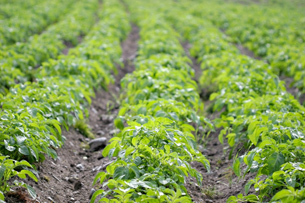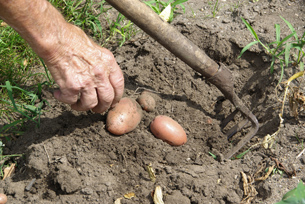Module 8
1. Module 8
1.6. Page 4
Module 8—Populations, Individuals, and Gene Pools
 Reflect on the Big Picture
Reflect on the Big Picture

© Joss/281349/Fotolia

© Lianem/8912279/Fotolia

© khz/648576/Fotolia
How important is allele variation in a population? Agriculture today represents a major departure from the early attempts of our ancestors at gathering local plants to provide scarce carbohydrates, vitamins, minerals, and medicines. A great variety of local herbs, roots, and berries were required to provide all the nutrients needed for survival, and early farming depended on the existence of many varieties that were suitable to the different habitats that existed. Today, the industrial monoculture farm uses the opposite practice by growing one particular variety of one species on a massive, economically efficient scale. For example, of the hundreds of varieties of potatoes that used to be grown on Earth, the vast majority grown today are of a few varieties that meet the massive consumer demand for a potato suitable for making French fries.
Wheat, rice, and livestock are raised in the same way—consumers demand a consistent product, resulting in a monoculture. The result is that genes for unprofitable varieties have, in many cases, disappeared.
If industrial-scale monoculture efficiently provides human populations with food, then perhaps it isn’t a problem. Apply your understanding of Unit C and your work in this lesson to reflect on the following questions:
- What would happen if the effects of climate change or the emergence of new plant diseases affected some of the crop?
- Would the entire crop and our food supply be affected because of the lack of variants that could survive the new threats?
- Do enough varieties of organisms still exist that their population could survive in a changed environment?
 Self-Check
Self-Check
SC 2. A population of 20 deer was introduced to an island where no deer had previously lived. Although there were several bucks (males of breeding age), one was much larger and stronger and was able to fight off the other bucks. The large buck was able to breed with the ten or so females in the breeding population. This same scenario repeated itself for three years in a row. Is this population in Hardy-Weinberg equilibrium? Why?
SC 3. State a reason why the following populations might NOT be in Hardy-Weinberg equilibrium.
- populations growing within range of radiation from the 1986 Chernobyl nuclear accident in Ukraine
- A mixed population of hooked-beaked and straight-beaked birds inhabited an island. With falling sea levels, a small group of birds were able to establish a colony on a nearby island. Almost all of those birds were, coincidentally, straight-beaked.
- Poplar trees are typically wind pollinated. In the absence of wind during flowering, many of the ovules are fertilized by pollen from the same flower.
- Evening scented stocks are flowers that give off a beautiful fragrance towards nightfall. Some flowers are more fragrant than others and attract more bees.
- In very strong winds, poplar pollen from very distant populations can be brought in and end up pollinating local plants.
 Self-Check Answers
Self-Check Answers
SC 2. No, it is not.
- The population is small.
- There is mate selection, not random mating.
- There is natural selection in that the strongest, largest deer (the most adapted) gets to breed and pass on his genes.
SC 3.
- change in mutation rate
- small population
- non-random mating
- natural selection
- open population (gene flow)
 Module 8: Lesson 1 Assignment
Module 8: Lesson 1 Assignment
Retrieve the copy of the Module 8: Lesson 1 Assignment that you saved to your computer earlier in this lesson. Complete Part B. Save your completed assignment in your course folder. Submit your completed Module 8: Lesson 1 Assignment to your teacher for assessment.